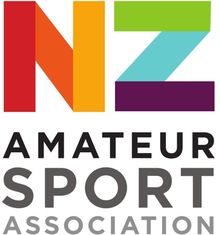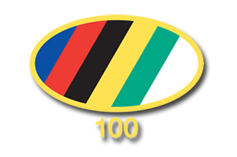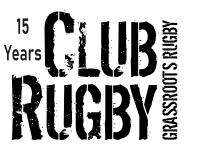Rich tapestry of clubs in Wellington

Above: The then captains of Wellington's second and third oldest clubs that are still in existence, Eugene Smith (Petone, founded in 1885) and Misipalauni Moananu (Poneke, 1883) leading their sides out on to Kilbirnie Park on the occasion of Poneke's 125th anniversary celebrations in 2008
As at the end of 2013, the Wellington Rugby Football Union had 18 member clubs affiliated to it, all of who have had at least one team taking part in the WRFU’s competitions; but what of the history of the club game in the capital? A perusal of the lists of championship winners, and the names engraved on the Jubilee and Hardham Cups themselves; reveal a number of names that have since disappeared; and many other names have also come and gone from the roll of clubs.Wellington FC (constituted in 1871) is not only the oldest club in the capital, but is the second oldest club in New Zealand by establishment behind the Nelson club, though unlike Nelson who have had periods of abeyance the Axemen have fielded a team every year since formation. The founder of the Wellington club, British Army officer JRC Isherwood, was also responsible for the forming of the city’s second club, Athletic, in 1877 and these two clubs were amongst those that formed the WRFU in 1879.
The inaugural WRFU Senior Championship was contested in 1880 between Wellington and Athletic, who played in the city division, and Greytown, Masterton and Carterton, who played in the Wairarapa division. Athletic were the first winners, beating Greytown 6-0 in the final on 31 July 1880 at the Basin Reserve.
The Wairarapa clubs played in the Wellington competitions until 1886 when they formed their own union. By that stage however a clutch of new clubs had sprung up in Wellington and the Hutt Valley including two famous clubs that remain in existence today, Poneke (1883) and Petone (1885). Poneke, like many early clubs actually started life as a ‘junior’ club and was originally constituted in 1882 as ‘Our Boys’ Club’.
The early years were not without struggle. Despite a stop-start introduction that included seeing off an early toehold by proponents of Australian Rules Football and the myriad of teething problems that could be expected, by 1900 rugby was firmly ensconced as the number one sporting code in Wellington.? The new English professional game of rugby league also rivaled rugby in the early years of the 21st century. Indeed, the first ‘All Golds’ tour to the UK in 1907 included several prominent Wellington rugby players of the time. Rugby league was also dominant in the Hutt Valley in pre-WW1 years.
The popularity of rugby saw no fewer than 57 different clubs established and affiliated to the WRFU at some point before the turn of the century. 1884 alone saw nine clubs join, none of which survive today. Indeed, many of the clubs during this time didn’t stick around long. Many were formed along mercantile lines or were offshoots of other fledgling sporting and non-sporting clubs and groups rather than being geographically aligned. Examples of early rugby clubs that came and went are Thorndon Classical School, Union-Diamond and Star. Others such as Athletic and Karori (Western Suburbs), Oriental (Oriental-Rongotai) and Taita (Avalon) were the original forerunners of today’s clubs. Some such as Selwyn, Southern and Melrose played in the Senior championship for many years.
Melrose was a notable early club, winning six Senior championships between 1896-1908,including three in a row between 1896-98. With its training facilities at Newtown Park, Melrose originally represented the Melrose borough, which incorporated large swathes of southern and western Wellington. But after Melrose amalgamated with the Wellington Town Board in 1903 the club of the same name slowly but surely lost its identity, before amalgamating with Selwyn in 1932 and then dropping out of existence sometime after that. ?
Other clubs that are now long forgotten also performed with distinction throughout these golden years of Wellington club rugby. One such example is St James’. One of a clutch of clubs that sprung up around the turn of last century, St James’ went within a whisker of winning the Senior championship in 1911. Holding a clear lead deep into the 18-round competition, St James’ grip on glory was only relinquished in the penultimate round when they were defeated 8-9 by then defending champions Oriental. Athletic then defeated Oriental in the season decider and St James’ found themselves relegated to third.
Another group synonymous with the game in Wellington, the Wellington Referees Association, was also formed before the turn of the century and was aligned with the WRFU in 1894. This organisation was the forerunner of today’s Wellington Rugby Referees Association which was formed in 1914.
The history of the grounds that the game was initially played on is also noteworthy. Early rugby was played on the Basin Reserve, then Newtown Park and then Athletic Park for the most part from 1896-1999. There was also an unsuccessful move for several seasons across the water to Miramar Park in the early 1900s. But a lack of patronage to watch games there and a tentative move by the fledgling rugby league game to move into Athletic Park heralded a move back there. The Petone and Hutt Recreation Grounds were also in use as rugby venues from early on.
Many of these early clubs played in the ‘Wednesday Championship’ that ran from 1896 until the outbreak of World War One in 1914 - the war and the introduction of ‘half holiday’ labour laws on Saturdays combining to spell the end of this once hotly contested grade. Petone won the first Wednesday Championship, but other clubs to win included ‘Tradesmen’, ‘Permanent Artillery’ and ‘Tramway’.
In 1904 there were 17 active clubs, fielding 43 teams to the official WRFU competitions. The following year, 1905, there were 20 clubs fielding 58 teams. By 1910 active players in the union totaled 1,400 in Saturday grades, 108 in the Wednesday Championship, as well as 500 in the school grades that are now administrated by College Sport Wellington but have at various times have come under the auspices of the WRFU.Schools.

Leading school teams such as Wellington College (formed 1879) and St Pat's College (1886) played in the WRFU competitions in these early years, competing for the WRFU's Junior Cup. From 1886 to 1903, St Pt's College (SPC) competed for the WRFU’s Junior Cup, which was won in 1888 by SPC by beating Epuni Club. Of note, SPC was not only unbeaten, but they scored more points than any other single Club in New Zealand in the 1888 season. In recognition of this victory, the entire College was granted a day’s holiday and a silk banner was commissioned which is still held in the College’s archives.
Out of the 17 matches played by SPC in 1888, 15 were won and two drawn. Sixty tries were obtained, and 16 of them were converted. Eleven goals were potted, bringing the total number of points up to 125. Only 9 points (a goal from a try, a potted goal, and 3 tries) were scored against the Club.
By 1912, there were 68 teams and 1,750 players playing in the senior competitions. Rugby was taking off. The game was flourishing and the Wellington representative team reclaimed the Ranfurly Shield. Most rugby was curtailed during World War One though the Senior championship was still contested; albeit with the strict caveat from the WRFU that ‘no unmarried man eligible for military service shall play rugby’. Athletic, Wellington (Athletic and Wellington declared joint winners in 1914) Petone and Poneke won Senior titles in the war years.
Poneke defended their title in 1919,a vintage season for Wellington rugby in which they took the Ranfurly Shield on the road and Wellington enjoyed a rich vein of form. On the club front, some 22 new clubs joined the WRFU’s Senior competitions in 1919-1939 period between the wars, though only one – Eastbourne – still survives as a standalone club.
The Centurions RFC was established in 1939, a club modeled on the Barbarians Club of London. World War Two again saw the amount of rugby restricted, though like in the First war the Senior competition continued. However with fewer players some clubs combined their efforts on the field such as Poneke and Oriental who won the competition in 1943 and 1944.
The decade following the war saw the establishment ofno fewer than 11 new clubs, mostly in the rapidly developing and expanding Western Bays and Hutt Valley.
In the latter part of the 20th century the club scene has continued to evolve and change. The late 1960’s and early 80’s & 90’s all saw high-profile amalgamations take place that have created many of the clubs of today, such as Oriental-Rongotai, Marist St Pats, Old Boys-University and Northern United. In fact, 8 of the current 18 clubs are the results of mergers that have occurred since the Paremata and Plimmerton clubs combined 1959, and that number will change again soon once the amalgamation of Upper Hutt and Rimutaka takes place.
While the traditional clubs have still enjoyed long periods of time in the sun, such as Petone who dominated for a decade from the mid 1960s to the mid 1970s, several community clubs have also flourished at one time or another. Three such community-based clubs that have won Jubilee Cups in the second half of Wellington club rugby’s history are Onslow (1955 and 1962, shared with Marist Brothers Old Boys), Western Suburbs (1998) and Tawa (2013). Western Suburbs itself is the result of a three-way amalgamation between Athletic (formed in 1877), Karori (1884) and Onslow (1922).
Here is a history of all the clubs that have been affiliated with the WRFU at various times (not counting known ‘college clubs’ such as Wellington College and St Patrick’s College Wellington that at various times have participated in the WRFU competitions):
1871 Wellington FC (NZ’s second club formed and the oldest continuous club)
1876 Greytown (Left WRFU to Wairarapa clubs formed own union in 1886)
1877 Athletic (Left WRFU to Wairarapa clubs formed own union in 1886)
1878 United, Excelsior, Union Jack
1879 Masterton (Left WRFU to Wairarapa clubs formed own union in 1886), Carterton (Left WRFU to Wairarapa clubs formed own union in 1886)
1883: Poneke (Formed as Our Boys’ Club in 1882), Ashley, Wellington Union
1884: Union-Diamond, Leopards, Mt Cook, Rivals, Rugby, Star, Thorndon Classical School, Karori (Originally formed in 1876, playing debut in 1884. Merged with Athletic and Onslow in 1983), United.
1885: Petone, Taita (Merged with Naenae Old Boys in 1980)
1886: Melrose (Formed out of the previous Star club (1884)), Epuni (Joined Petone in 1891)
Orient, Welcome.
1887: Belmont, Pirates
1888: Albatross, Oriental, Carlton, Everton, Oriental (Merged with Rongotai College Old Boys in 1968), Petone-Albion (Joined Petone in 1889), Pioneer, Rapids
1889: Clifton, Midland, Naval Artillery, Selwyn, Sydenham, Wanderers
1890: Montrose, Prince Albert, Red Star, Roseneath
1892: Epuni (A separate club to that formed in 1886. Merged with Kia Ora in 1910), United Trademen
1893: Half-Holiday Drapers
1895: Brooklyn, Merrivale (Amalgamated with Petone same season as forming)
1896: St John’s
1897: Wellington College Old Boys (Merged with Victoria University in 1992)
1898: Kia Ora (Merged with Epuni in 1910)
1899: Southern, Wellington? Rowing Club
1901: St James’, Kaiwarra
1902: Waratah
1903: Victoria University (Merged with Wellington College Old Boys in 1992)
1904: Johnsonville, Railway
1905: Institute Old Boys, St David’s, United (A separate club to the one of the same name (1884)), Star Boating Club
1907: Polhill, Bakers
1908: St John’s, Boys’ Institute, Tramways, Butchers, Artillery, Marist Old Boys
1909: Upper Hutt (merging with Rimutaka in 2014), Exchange, St Patrick’s College Old Boys (Merged with Marist Brothers in 1971)
1910: Hutt (An amalgamation of the Epuni (1892) and Kia Ora clubs), Porirua (Merged with Titahi Bay in 1990)
Waiwhetu
1912: Wadestown, Wellington Catholic
1913: Berhampore (Changed its name to Pirates in 1936)
1914: United Methodists
1918: Trentham, Railway Battalion, YMCA
1919: Marist Brothers Old Boys (Merged with St Patrick’s College Old Boys in 1971), War Expenses, Mascot
1920: Miramar (Merged with Seatoun-Rongotai College Old Boys in 1950), HMS Amokura
1921: Eastbourne, Boys’ Institute Old Boys, Public Service
1922: Technical College Old Boys, Onslow (Merged with Athletic &Karori in 1983), Khandallah (Joined the Onslow club in 1926)
1923: Foresters (Joined the Wellington Football Club in 1926), Community, Olympic
1924: Brooklyn United
1925: Scots College Old Boys
1929: Seatoun (Merged with Rongotai College (‘school’ club) in 1936), Moera, Railway Training School
1931: Plimmerton (Merged with Paremata in 1959)
1932: Melrose-Selwyn (An amalgamation of the Melrose and Selwyn clubs)
1936: Seatoun-Rongotai College Old Boys (An amalgamation of the Seatoun club&the Rongotai College ‘school’ club. Merged with Miramar in 1951)
1940: Air Force
1943: Navy, Fortress Maoris
1945: Paremata (Merged with Plimmerton in 1959), Woburn (Name change in 1953 to High School Old Boys)
1946: Wainuiomata, Belmont, Makara,
1947: Tawa, Te Tau Aroha
1949: Stokes Valley
1950: Eastern Suburbs (An amalgamation of Miramar and Seatoun-Rongotai Old Boys clubs. Renamed Rongotai College Old Boys in 1966. Merged with Oriental in 1968)
1951: Naenae Old Boys (Merged with Taita in 1980)
1952: Kimi Ora, Marist Brothers Old Boys (Merged with Hutt Old Boys in 1993)
1955: Titahi Bay (Merged with Porirua in 1990)
1959: Paremata-Plimmerton (An amalgamation of the Paremata and Plimmerton clubs)
1967: Hutt Old Boys (An amalgamation of the Hutt and High School Old Boys’ clubs. Merged with Marist Brothers Old Boys)
1968: Oriental-Rongotai (An amalgamation of the Oriental and Rongotai College Old Boys clubs)
1971: Marist St Pat’s (An amalgamation of the Marist Old Boys and St Pat’s Old Boys clubs)
1980: Avalon (An amalgamation of the Naenae Old Boys and Taita clubs)
1982 Rimutaka (Merging with Upper Hutt in 2014)
1983: Western Suburbs (An Amalgamation of the Onslow, Karori and Athletic clubs)
1990: Northern United (An amalgamation of the Titahi Bay and Porirua clubs)
1992: Old Boys University (An amalgamation of the Victoria University and Wellington College Old Boys clubs. Originally called Harlequins)
1993: Hutt Old Boys Marist (An amalgamation of the Marist Brothers Old Boys (Hutt Valley) and Hutt Old Boys clubs)
2014: Upper Hutt Rams RFC (An amalgamation of the Upper Hutt and Rimutaka clubs)
?
Steven White, 19 Mar 2019
Adam Julian, 19 Mar 2019
Steven White, 12 Mar 2019
Adam Julian, 04 Mar 2019
Steven White, 12 Feb 2019








.jpg)





